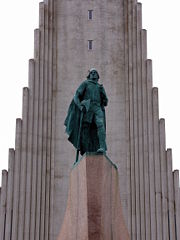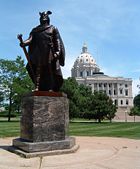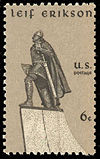Leif Ericson
2008/9 Schools Wikipedia Selection. Related subjects: Geographers and explorers

Leif Ericson ( Old Norse: Leifr Eiríksson) (c. 970 – c. 1020) was a Norse explorer who was probably the first European to land in North America (excluding Greenland). According to the Sagas of Icelanders, he established a Norse settlement at Vinland, which has been tentatively identified with the L'Anse aux Meadows Norse site on the northern tip of the island of Newfoundland in Newfoundland and Labrador, Canada.
Biography
Early life in Greenland
It is believed that Leif was born about AD 970 in Iceland, the son of Erik the Red ( Old Norse: Eiríkr inn rauði), a Norse explorer and outlaw and himself the son of a Norse outlaw, Þorvaldr Ásvaldsson. Leif's mother was Thjodhild (Þjóðhildr). Erik the Red had founded two Norse colonies in Greenland, the Western Settlement and the Eastern Settlement, as he had named them.
Leif Erikson had two younger brothers, Thorvaldr and Thorsteinn, and one sister, Freydís. Leif married a woman named Thorgunna, and they had one son, Thorkell Leifsson.
Exploring west of Greenland
During a stay in Norway, Leif Ericson converted to Christianity, like many Norse of that time. He also went to Norway to serve the King of Norway, Olaf I. When he returned to Greenland, he bought the boat from Bjarni Herjólfsson and set out to explore the land that Bjarni had found (located west of Greenland), which was likely Newfoundland, Canada.
The Saga of the Greenlanders tells that Leif set out in the year 1003 to follow Bjarni's route with 35 crew members, but going north.
The first land he went to was covered with flat and shiny rocks (Old Norse: hellur, German: "hell"). He therefore called it Helluland ("Land of the Flat Stones"). This was possibly Baffin Island. Next he came to a land that was flat and wooded, with white sandy beaches. He called this Markland ("Wood-land"), which is possibly Labrador.
Settlement in Vinland
Leif and his crew left Markland and again found land, which they named Vinland. They landed and built a small settlement. They found the area pleasant: there were plenty of salmon in the river and the climate was mild, with little frost in the winter and green grass year-round. They remained in the region over the winter.
The sagas mention that one of Leif's men, Tyrkir, possibly a Hungarian (because at that time the Hungarians were referred to as Turks) or a German, found wild grapes.
On the return voyage, Leif rescued an Icelandic castaway named Þórir and his crew — an incident that earned Leif the nickname Leif the Lucky (Old Norse: Leifr hinn heppni).
Research done in the 1950s and 1960s by explorer Helge Ingstad and his wife, archaeologist Anne Stine, identified a Norse settlement located at the northern tip of Newfoundland, known as L'Anse aux Meadows, which many have connected to Leif's settlement.
United States commemoration
In 1964, the United States Congress authorized and requested the president to proclaim October 9 of each year as " Leif Ericson Day". That date was chosen for its connection to the first organized immigration from Norway to the United States, not for any event in the life of the explorer. The day is also an official observance of several U.S. states.
Speculation
A few have speculated that Norsemen may have penetrated as far as modern day Minnesota, either coming down from Hudson Bay or going west through the Great Lakes. A runestone with carvings of a Scandinavian nature was discovered near Kensington, Minnesota, aptly titled the Kensington Runestone. In the 19th century, the theory that Ericson and his men visited New England gained in popularity. The statue of Ericsson on Commonwealth Ave. in Boston, Massachusetts and the Norumbega Tower in Weston, Massachusetts were both created as monuments to the vision of this Viking presence.
An 11th century Norse coin, the Maine Penny, was found in Brooklin, Maine along with thousands of other artifacts during an excavation of a former Native American trading centre. However, it is noted that this coin may have made it from Newfoundland via trade or may have even been brought to North America centuries later by the English or Portuguese. Although there have been numerous attempts over the decades to show Viking presence in United States, such as translations of stone carvings, or possible European traits in some Native American tribes, the professional archaeological community has not yet whole-heartedly accepted this claim.

